Maths quiz grade 6 final round
Download as pptx, pdf14 likes11,836 views
Inter Club Maths Quiz For Grade-6 held on 22nd December at Presidium Indirapuram, 2015
1 of 37
Downloaded 285 times
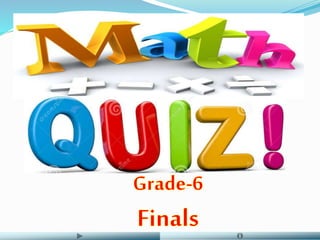
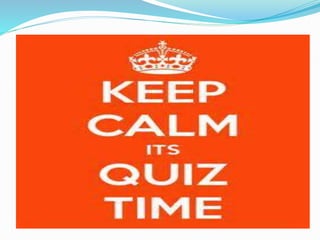


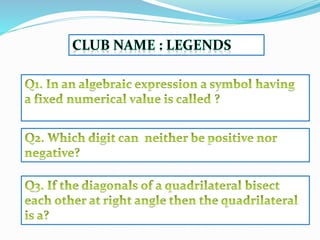


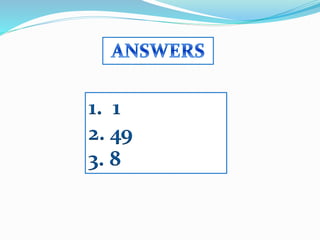
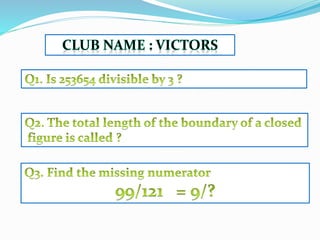
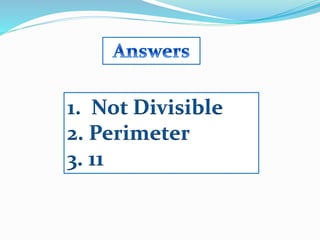

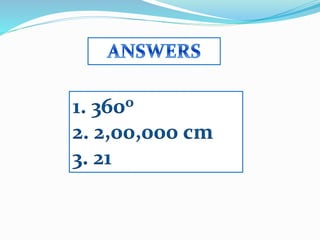
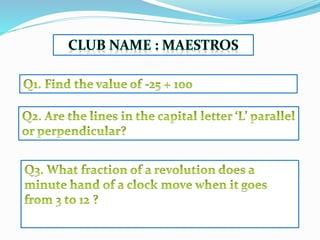
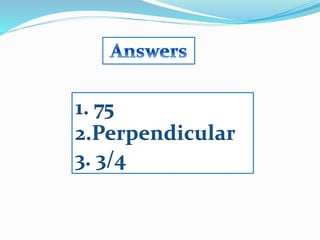

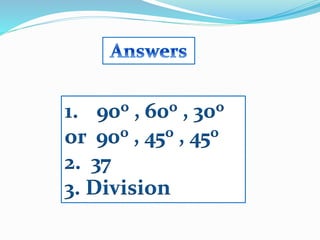
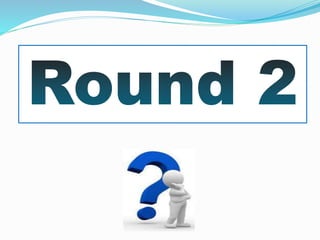
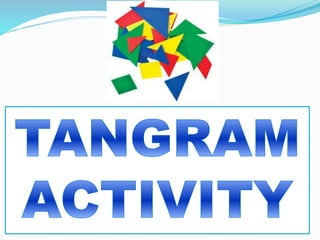
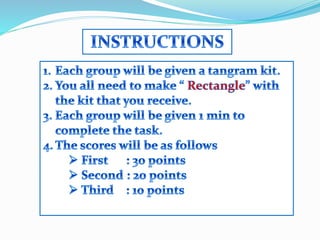

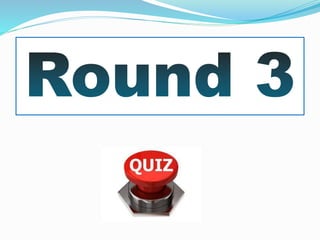
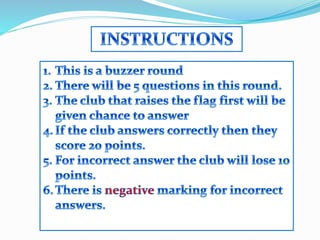

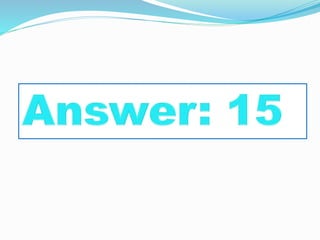
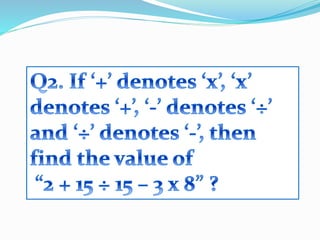


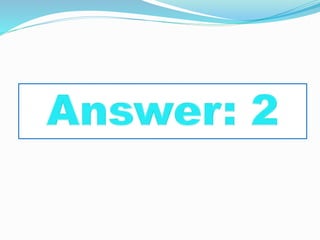


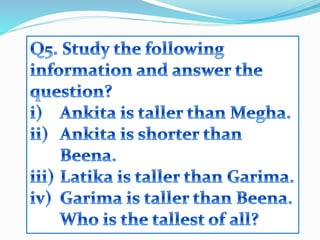
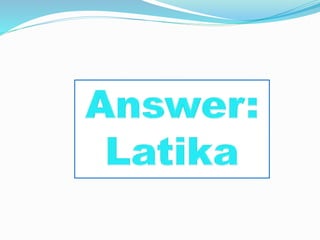

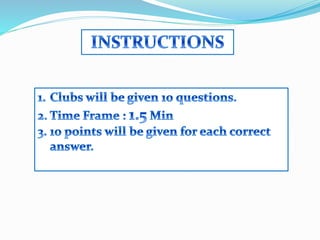
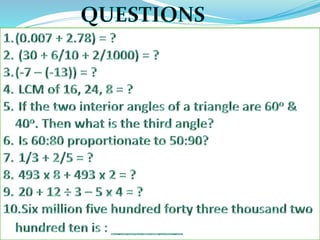
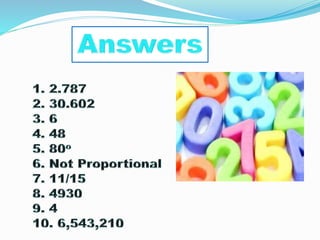

Ad
Recommended
Strategic Intervention Material (SIM) Science-CIRCULATORY AND RESPIRATORY SYSTEM
Strategic Intervention Material (SIM) Science-CIRCULATORY AND RESPIRATORY SYSTEMSophia Marie Verdeflor
╠²
The document provides information about the circulatory system. It explains that the circulatory system is responsible for transporting nutrients, water, oxygen, and waste throughout the body using the heart, blood vessels, and blood. The heart pumps blood through a network of arteries, veins, and capillaries. Arteries carry oxygenated blood away from the heart while veins carry deoxygenated blood back to the heart. Capillaries allow for the exchange of gases, water, and nutrients between blood and body tissues. The document also describes the components and functions of the heart and blood in more detail.Grade 6 mtap reviewer
Grade 6 mtap reviewerEclud Sugar
╠²
The document is a compilation of math problems and challenges designed for sixth-grade students, prepared in collaboration with Metrobank, MTAP, and DepEd for the 2008 math challenge. It covers a wide range of topics including arithmetic, geometry, fractions, percentages, and word problems. Each problem requires students to solve and write their answers, emphasizing critical thinking and mathematical skills.Youth for Environment in Schools Organization (YES-O.pptx
Youth for Environment in Schools Organization (YES-O.pptxBEARPADILLOCALOYLOY
╠²
The YES O was established through a Department Order to be a school-based organization that promotes environmental protection and conservation for future generations through awareness campaigns, clean-up drives, waste management programs, and other projects. The YES O consolidates all environmental clubs in a school and is the only recognized co-curricular environment club. It aims to increase awareness of environmental issues, establish programs to address these issues, and encourage community participation in environmental initiatives.KKK and the Kartilya ng Katipunan PPT.pptx
KKK and the Kartilya ng Katipunan PPT.pptxCarlosDavid168
╠²
The Katipunan was a secret revolutionary society founded on July 7, 1892 in Manila by Andres Bonifacio with the aim of gaining independence from Spanish colonial rule. It had a hierarchical structure of councils at the national, provincial and local levels. Bonifacio was the Supremo and Emilio Jacinto was an important leader and writer. The Katipunan recruited members using a triangle system and had degrees of membership. It established a printing press to publish its newspaper Kalayaan and spread its message of revolution.Sample Lesson Plan: Finding the Area of a Composite Figure
Sample Lesson Plan: Finding the Area of a Composite FigureCRISALDO CORDURA
╠²
The document outlines a mathematics lesson plan for 6th grade students in the Philippines focusing on understanding and calculating the area of composite figures involving triangles, squares, rectangles, circles, and semi-circles. It includes learning objectives, teaching strategies, activities, and evaluation methods, emphasizing real-life applications of area calculation. The plan is prepared by Mr. Crisaldo H. Cordura and involves interactive classroom activities to engage students in mathematical reasoning and problem-solving.GRADE 10 GLOBALISASYON
GRADE 10 GLOBALISASYONLavinia Lyle Bautista
╠²
Ang dokumento ay nagbibigay ng detalyadong pagsusuri sa globalisasyon, kabilang ang mga depinisyon, pinagmulan, at iba't ibang katangian nito. Tinalakay ang mga konsepto tulad ng integration, de-localization, at ang mga hamon at solusyon sa globalisasyon, tulad ng 'guarded globalization' at 'fair trade'. Naglalaman din ito ng mga pananaw mula sa mga kilalang iskolar tungkol sa kahalagahan at epekto ng globalisasyon sa mga aspeto ng ekonomiya, politika, kultura, at lipunan.Grade 5 science quiz bee
Grade 5 science quiz beeKristine Barredo
╠²
This document contains a science quiz with multiple choice questions ranging from easy to difficult. The quiz covers topics in biology, chemistry, physics and earth science such as the process of burning wood, types of infections, characteristics of insects, names of inner planets, identifying animal teeth structures, how the uterus accommodates a baby, advantages of fluorescent lamps over incandescent, identifying components of urine, testing for the presence of starch, and female menstruation.Science quiz bee questions
Science quiz bee questionsTricia Geene Orfinada
╠²
This document contains the questions and answers from multiple rounds of a science quiz bee, including easy, average, difficult, and clincher rounds. The questions cover topics in biology, chemistry, physics, and other sciences. They test knowledge about the classification of living things, cells, astronomy, geology, physics concepts like refraction, and the discoveries of famous scientists.Math action plan 2019
Math action plan 2019Jocelyn Tamares
╠²
This document outlines an action plan for mathematics at Maruhat National High School for the 2019-2020 school year. The plan includes administering pre-tests, quarterly tests, and post-tests to assess student performance; using differentiated instruction techniques to increase performance; conducting drills to reduce the number of non-numerates; organizing a math club; holding a school-based math competition; training student participants for the division math competition; improving teacher competencies through professional development; restructuring the math room and math park; and preparing the plan with input from teachers, administrators, students and stakeholders. The expected outputs are increased student performance, reduced non-numerates, an organized math club, enhanced student skills, well-trainedMath-Quiz-Bee.ppt
Math-Quiz-Bee.pptVivianPercela1
╠²
This document contains 3 rounds of a math quiz bee with 20 questions each. The easy round covers basic math concepts like properties of numbers, exponents, sequences, percentages and ratios. The average round increases difficulty slightly with questions on coordinate planes, proportions, percentages and prime numbers. The difficult round contains multi-step word problems involving interest, probabilities, combinatorics and geometry.detailed lesson plan - ratio and proportion
detailed lesson plan - ratio and proportionAubrey Rose
╠²
This detailed lesson plan outlines a math lesson on ratios for students. The teacher will define and provide examples of ratios, including expressing them in colon and fraction form. Students will be divided into groups to complete ratio tasks and present their work to the class. Examples of ratio problems include comparing numbers of letters in the alphabet, numbers of animals in pictures, and rational expressions. The lesson aims to help students understand what a ratio is and how to express ratios in different ways.Grade 4 science quiz bee
Grade 4 science quiz beeKristine Barredo
╠²
This document contains a science quiz with multiple choice questions testing knowledge of various science topics. It includes questions about biology, anatomy, earth science, and other domains. The quiz is divided into easy, average, difficult, and clincher rounds with increasing challenge. Questions cover topics such as muscles, reproduction, minerals, climate, physics, and ecology.Strategic Intervention Material (SIM) Mathematics-TWO-COLUMN PROOF
Strategic Intervention Material (SIM) Mathematics-TWO-COLUMN PROOFSophia Marie Verdeflor
╠²
The document provides instructions for writing two-column geometric proofs. It explains that a two-column proof consists of statements in the left column and reasons for those statements in the right column. Each step of the proof is a row. It then gives examples of properties that can be used as reasons, such as angle addition postulate, congruent supplements theorem, and triangle congruence postulates. Sample proofs are also provided to illustrate the two-column format.7. solving two step word problems involving addition and subtraction of whole...
7. solving two step word problems involving addition and subtraction of whole...Annie Villamer
╠²
This document provides examples and steps for solving two-step word problems involving addition and subtraction of whole numbers and money. It includes sample problems such as calculating the number of mangoes left after combining amounts picked and sold. The document also outlines George Polya's four-step approach to problem solving: understand the problem, make a plan, carry out the plan, and look back. Sample problems are then shown being solved using this approach.Problems involving sets
Problems involving setsBatangas National High School
╠²
This document presents a lesson on solving word problems involving sets. It begins by stating the objectives of the lesson which are to apply set operations to word problems, solve word problems using Venn diagrams, and participate in group activities. It then provides examples of word problems involving sets and demonstrates how to analyze them using Venn diagrams and set operations. The document aims to show students how to solve real-world problems involving sets.Action plan in math
Action plan in mathGel Joseph Cochico
╠²
This document outlines the Department of Education Region III Central Luzon's action plan for mathematics for the 2016-2017 school year. It details six pupil development projects aimed at improving mathematics proficiency, including Project GIM to master multiplication tables, Project ESEM to raise proficiency levels, and Project ALL NUMERATES to master the four fundamental operations. It also covers staff development through in-service teacher training, curriculum development through creating instructional materials, and improving physical learning environments. The overall goals are to enhance teacher competence and student achievement in mathematics.Product of Two Binomials (FOIL Method)
Product of Two Binomials (FOIL Method)Carlo Luna
╠²
This document contains notes from an 8th grade mathematics class on patterns and algebra during the first quarter. It includes examples of simplifying expressions using properties like the distributive property. Students practiced multiplying binomial expressions using both the FOIL and box methods. The class concluded with an easy, average, and difficult quiz to test students' skills in simplifying and multiplying algebraic expressions.Integer lesson plan
Integer lesson planpreya leandrina
╠²
This document outlines a lesson plan on integer operations with the following objectives:
1) Define integers and integer operation rules
2) Solve problems involving integer operations
3) Relate integers to real-world applications
The lesson will include motivation games to introduce integers, group activities with flashcards to practice operations, and a discussion of integer definitions and rules. It will conclude by connecting integers to a real-world video example and giving an evaluation of integer operation problems.Evaluating Algebraic Expressions - Math 7 Q2W4 LC1
Evaluating Algebraic Expressions - Math 7 Q2W4 LC1Carlo Luna
╠²
This document provides instruction on evaluating algebraic expressions. It begins with an opening prayer related to mathematics. It then states the learning competency and objectives which are to evaluate expressions for given variable values and real-life expressions. Various math terms are defined such as constant, variable, term, and exponent. Examples of evaluating multi-step expressions are provided using the order of operations. The document also discusses substituting values for variables and performing operations. Real-life examples on costs are presented for students to evaluate. In closing, key ideas are summarized in notes on algebraic expressions, constants, variables, and the process of evaluating expressions.MTAP REVIEWER Grade 4...part 1
MTAP REVIEWER Grade 4...part 1Rigino Macunay Jr.
╠²
This document contains a math review test for grade 4 students with multiple choice and word problems. It is divided into 3 parts from 2004, 2005, and 2006 with questions ranging from basic math operations to geometry, measurement, time, money, fractions, ratios, and word problems. The test assesses a wide range of grade 4 math skills and concepts.4 pics 1 word math version
4 pics 1 word math versionGem Lamsen
╠²
This document is a grid of letters arranged in rows and columns with no spaces or punctuation. It contains 40 rows with 35 letters each for a total of 1,400 letters. The letters are seemingly randomly arranged with no obvious words or patterns.Subtraction without and with regrouping 3 4 digit numbers
Subtraction without and with regrouping 3 4 digit numbersYolanda N. Bautista
╠²
Sean sold 342 boxes of cupcakes last week and 557 boxes this week. To find the increase in sales, we subtract last week's amount from this week's, giving 557 - 342 = 215. Another method is to write the numbers as 4986 - 2354 = 2632 to find the difference between them by arranging the digits in columns and subtracting. Subtraction allows regrouping of digits when the number in the top row is less than the number below it in a column.Strategic intervention material discriminant and nature of the roots
Strategic intervention material discriminant and nature of the rootsmaricel mas
╠²
This document provides guidance on identifying the nature of roots for quadratic equations. It begins by explaining that the discriminant, which is calculated as b^2 - 4ac, can be used to determine if the roots are real, rational, equal, etc. Several examples are worked through to demonstrate rewriting equations in standard form, finding a, b, and c values, and calculating the discriminant. Activities are included for students to practice these skills. The document concludes by summarizing that a positive discriminant indicates real, unequal roots, a negative discriminant indicates non-real roots, and a zero discriminant indicates real, equal roots.Lesson Plan in Mathematics 3
Lesson Plan in Mathematics 3Emilio Fer Villa
╠²
This document is a lesson plan for teaching basic division facts of numbers up to 10, focusing on orderliness and cooperation. It includes instructional procedures, activities, and evaluation methods involving group games and discussions to reinforce multiplication and division concepts. The lesson aims to help students understand the inverse relationship between multiplication and division through interactive exercises.Sample of-detailed-lesson-plan-grade-3 (1)
Sample of-detailed-lesson-plan-grade-3 (1)GodwinBabaran1
╠²
This document outlines a math lesson plan for teaching students to convert between units of time such as days, weeks, months, and years. The objectives are for students to understand and apply conversions of time measures and solve related problems. The lesson plan includes reviewing concepts, examples of conversions, group activities with word problems, and a formative assessment to evaluate learning. The reflection section considers students' mastery of the content and the effectiveness of the teaching strategies.DETAILED LESSON PLAN (MATH 6)
DETAILED LESSON PLAN (MATH 6)Ryan Parpa
╠²
The document outlines a lesson plan on multiplying fractions in simple and mixed forms. It includes objectives, subject matter, learning experiences such as motivation, presentation of sample problems, and evaluation. Students will learn to change mixed numbers to improper fractions, multiply numerators and denominators, and reduce to lowest terms when multiplying fractions.Ratio and Proportion Lesson Plan for Grade 5
Ratio and Proportion Lesson Plan for Grade 5Rae Anne Sapu-an
╠²
The document outlines a lesson plan on ratios and proportions in mathematics. The objectives are for students to define and identify ratios, solve proportions, and understand the real-life applications of ratios and proportions. The lesson plan details the teacher's activities such as reviewing concepts, presenting new material through examples, discussion, and practice problems. It also includes student activities like solving problems and group work. Key concepts covered are defining ratios as comparisons of quantities and proportions as equal ratios. Students learn to set up and solve ratios and proportions, including finding missing terms. The lesson emphasizes applying ratios and proportions to everyday situations like baking.Grade 6 science quiz bee
Grade 6 science quiz beeKristine Barredo
╠²
The document contains a science quiz with multiple choice questions covering various topics in science from the human body to the solar system to the Earth's layers. It includes three rounds of questions - Easy, Average, and Difficult - with 10 questions in each round covering topics such as the functions of bones and minerals, the layers of the Earth, the circulatory system, and more. The questions increase in difficulty from the Easy to the Difficult rounds.Grade 5 maths
Grade 5 mathsRenier Scheepers
╠²
The Grade 5 Maths Final Exam Scope for 2014 covers a wide range of topics including operations with numbers like expanded notation, rounding, addition and subtraction. It also covers ordering numbers, factors, problem solving, converting units of length, geometric patterns, 3D objects, spatial relationships, temperature, and collecting and analyzing data. Students will be tested on their understanding of these essential math concepts.More Related Content
What's hot (20)
Math action plan 2019
Math action plan 2019Jocelyn Tamares
╠²
This document outlines an action plan for mathematics at Maruhat National High School for the 2019-2020 school year. The plan includes administering pre-tests, quarterly tests, and post-tests to assess student performance; using differentiated instruction techniques to increase performance; conducting drills to reduce the number of non-numerates; organizing a math club; holding a school-based math competition; training student participants for the division math competition; improving teacher competencies through professional development; restructuring the math room and math park; and preparing the plan with input from teachers, administrators, students and stakeholders. The expected outputs are increased student performance, reduced non-numerates, an organized math club, enhanced student skills, well-trainedMath-Quiz-Bee.ppt
Math-Quiz-Bee.pptVivianPercela1
╠²
This document contains 3 rounds of a math quiz bee with 20 questions each. The easy round covers basic math concepts like properties of numbers, exponents, sequences, percentages and ratios. The average round increases difficulty slightly with questions on coordinate planes, proportions, percentages and prime numbers. The difficult round contains multi-step word problems involving interest, probabilities, combinatorics and geometry.detailed lesson plan - ratio and proportion
detailed lesson plan - ratio and proportionAubrey Rose
╠²
This detailed lesson plan outlines a math lesson on ratios for students. The teacher will define and provide examples of ratios, including expressing them in colon and fraction form. Students will be divided into groups to complete ratio tasks and present their work to the class. Examples of ratio problems include comparing numbers of letters in the alphabet, numbers of animals in pictures, and rational expressions. The lesson aims to help students understand what a ratio is and how to express ratios in different ways.Grade 4 science quiz bee
Grade 4 science quiz beeKristine Barredo
╠²
This document contains a science quiz with multiple choice questions testing knowledge of various science topics. It includes questions about biology, anatomy, earth science, and other domains. The quiz is divided into easy, average, difficult, and clincher rounds with increasing challenge. Questions cover topics such as muscles, reproduction, minerals, climate, physics, and ecology.Strategic Intervention Material (SIM) Mathematics-TWO-COLUMN PROOF
Strategic Intervention Material (SIM) Mathematics-TWO-COLUMN PROOFSophia Marie Verdeflor
╠²
The document provides instructions for writing two-column geometric proofs. It explains that a two-column proof consists of statements in the left column and reasons for those statements in the right column. Each step of the proof is a row. It then gives examples of properties that can be used as reasons, such as angle addition postulate, congruent supplements theorem, and triangle congruence postulates. Sample proofs are also provided to illustrate the two-column format.7. solving two step word problems involving addition and subtraction of whole...
7. solving two step word problems involving addition and subtraction of whole...Annie Villamer
╠²
This document provides examples and steps for solving two-step word problems involving addition and subtraction of whole numbers and money. It includes sample problems such as calculating the number of mangoes left after combining amounts picked and sold. The document also outlines George Polya's four-step approach to problem solving: understand the problem, make a plan, carry out the plan, and look back. Sample problems are then shown being solved using this approach.Problems involving sets
Problems involving setsBatangas National High School
╠²
This document presents a lesson on solving word problems involving sets. It begins by stating the objectives of the lesson which are to apply set operations to word problems, solve word problems using Venn diagrams, and participate in group activities. It then provides examples of word problems involving sets and demonstrates how to analyze them using Venn diagrams and set operations. The document aims to show students how to solve real-world problems involving sets.Action plan in math
Action plan in mathGel Joseph Cochico
╠²
This document outlines the Department of Education Region III Central Luzon's action plan for mathematics for the 2016-2017 school year. It details six pupil development projects aimed at improving mathematics proficiency, including Project GIM to master multiplication tables, Project ESEM to raise proficiency levels, and Project ALL NUMERATES to master the four fundamental operations. It also covers staff development through in-service teacher training, curriculum development through creating instructional materials, and improving physical learning environments. The overall goals are to enhance teacher competence and student achievement in mathematics.Product of Two Binomials (FOIL Method)
Product of Two Binomials (FOIL Method)Carlo Luna
╠²
This document contains notes from an 8th grade mathematics class on patterns and algebra during the first quarter. It includes examples of simplifying expressions using properties like the distributive property. Students practiced multiplying binomial expressions using both the FOIL and box methods. The class concluded with an easy, average, and difficult quiz to test students' skills in simplifying and multiplying algebraic expressions.Integer lesson plan
Integer lesson planpreya leandrina
╠²
This document outlines a lesson plan on integer operations with the following objectives:
1) Define integers and integer operation rules
2) Solve problems involving integer operations
3) Relate integers to real-world applications
The lesson will include motivation games to introduce integers, group activities with flashcards to practice operations, and a discussion of integer definitions and rules. It will conclude by connecting integers to a real-world video example and giving an evaluation of integer operation problems.Evaluating Algebraic Expressions - Math 7 Q2W4 LC1
Evaluating Algebraic Expressions - Math 7 Q2W4 LC1Carlo Luna
╠²
This document provides instruction on evaluating algebraic expressions. It begins with an opening prayer related to mathematics. It then states the learning competency and objectives which are to evaluate expressions for given variable values and real-life expressions. Various math terms are defined such as constant, variable, term, and exponent. Examples of evaluating multi-step expressions are provided using the order of operations. The document also discusses substituting values for variables and performing operations. Real-life examples on costs are presented for students to evaluate. In closing, key ideas are summarized in notes on algebraic expressions, constants, variables, and the process of evaluating expressions.MTAP REVIEWER Grade 4...part 1
MTAP REVIEWER Grade 4...part 1Rigino Macunay Jr.
╠²
This document contains a math review test for grade 4 students with multiple choice and word problems. It is divided into 3 parts from 2004, 2005, and 2006 with questions ranging from basic math operations to geometry, measurement, time, money, fractions, ratios, and word problems. The test assesses a wide range of grade 4 math skills and concepts.4 pics 1 word math version
4 pics 1 word math versionGem Lamsen
╠²
This document is a grid of letters arranged in rows and columns with no spaces or punctuation. It contains 40 rows with 35 letters each for a total of 1,400 letters. The letters are seemingly randomly arranged with no obvious words or patterns.Subtraction without and with regrouping 3 4 digit numbers
Subtraction without and with regrouping 3 4 digit numbersYolanda N. Bautista
╠²
Sean sold 342 boxes of cupcakes last week and 557 boxes this week. To find the increase in sales, we subtract last week's amount from this week's, giving 557 - 342 = 215. Another method is to write the numbers as 4986 - 2354 = 2632 to find the difference between them by arranging the digits in columns and subtracting. Subtraction allows regrouping of digits when the number in the top row is less than the number below it in a column.Strategic intervention material discriminant and nature of the roots
Strategic intervention material discriminant and nature of the rootsmaricel mas
╠²
This document provides guidance on identifying the nature of roots for quadratic equations. It begins by explaining that the discriminant, which is calculated as b^2 - 4ac, can be used to determine if the roots are real, rational, equal, etc. Several examples are worked through to demonstrate rewriting equations in standard form, finding a, b, and c values, and calculating the discriminant. Activities are included for students to practice these skills. The document concludes by summarizing that a positive discriminant indicates real, unequal roots, a negative discriminant indicates non-real roots, and a zero discriminant indicates real, equal roots.Lesson Plan in Mathematics 3
Lesson Plan in Mathematics 3Emilio Fer Villa
╠²
This document is a lesson plan for teaching basic division facts of numbers up to 10, focusing on orderliness and cooperation. It includes instructional procedures, activities, and evaluation methods involving group games and discussions to reinforce multiplication and division concepts. The lesson aims to help students understand the inverse relationship between multiplication and division through interactive exercises.Sample of-detailed-lesson-plan-grade-3 (1)
Sample of-detailed-lesson-plan-grade-3 (1)GodwinBabaran1
╠²
This document outlines a math lesson plan for teaching students to convert between units of time such as days, weeks, months, and years. The objectives are for students to understand and apply conversions of time measures and solve related problems. The lesson plan includes reviewing concepts, examples of conversions, group activities with word problems, and a formative assessment to evaluate learning. The reflection section considers students' mastery of the content and the effectiveness of the teaching strategies.DETAILED LESSON PLAN (MATH 6)
DETAILED LESSON PLAN (MATH 6)Ryan Parpa
╠²
The document outlines a lesson plan on multiplying fractions in simple and mixed forms. It includes objectives, subject matter, learning experiences such as motivation, presentation of sample problems, and evaluation. Students will learn to change mixed numbers to improper fractions, multiply numerators and denominators, and reduce to lowest terms when multiplying fractions.Ratio and Proportion Lesson Plan for Grade 5
Ratio and Proportion Lesson Plan for Grade 5Rae Anne Sapu-an
╠²
The document outlines a lesson plan on ratios and proportions in mathematics. The objectives are for students to define and identify ratios, solve proportions, and understand the real-life applications of ratios and proportions. The lesson plan details the teacher's activities such as reviewing concepts, presenting new material through examples, discussion, and practice problems. It also includes student activities like solving problems and group work. Key concepts covered are defining ratios as comparisons of quantities and proportions as equal ratios. Students learn to set up and solve ratios and proportions, including finding missing terms. The lesson emphasizes applying ratios and proportions to everyday situations like baking.Viewers also liked (20)
Grade 6 science quiz bee
Grade 6 science quiz beeKristine Barredo
╠²
The document contains a science quiz with multiple choice questions covering various topics in science from the human body to the solar system to the Earth's layers. It includes three rounds of questions - Easy, Average, and Difficult - with 10 questions in each round covering topics such as the functions of bones and minerals, the layers of the Earth, the circulatory system, and more. The questions increase in difficulty from the Easy to the Difficult rounds.Grade 5 maths
Grade 5 mathsRenier Scheepers
╠²
The Grade 5 Maths Final Exam Scope for 2014 covers a wide range of topics including operations with numbers like expanded notation, rounding, addition and subtraction. It also covers ordering numbers, factors, problem solving, converting units of length, geometric patterns, 3D objects, spatial relationships, temperature, and collecting and analyzing data. Students will be tested on their understanding of these essential math concepts.Chapter 6 Nutrition in Humans Lesson 1 - The Need for Digestion
Chapter 6 Nutrition in Humans Lesson 1 - The Need for Digestionj3di79
╠²
The document summarizes digestion in the human digestive system. It describes the stages of digestion that occur in the mouth, stomach, and small intestine. In the mouth, mechanical and chemical digestion breaks down food. The stomach contains gastric glands that secrete enzymes and acid to digest proteins. The small intestine completes digestion with enzymes from the pancreas, liver, and intestinal walls that break down fats, proteins, and carbs into smaller molecules for absorption.Whiz Kid 4th Grade Math
Whiz Kid 4th Grade MathTerrell Johnson
╠²
This document provides an overview of grade 4 math topics including mental math, order of operations, word problems, and relevant Massachusetts frameworks. It contains examples of multiplication and division problems to solve mentally as well as multi-step word problems involving the four basic operations. The frameworks reference standards related to selecting the appropriate operation to solve problems, accurately performing multi-digit calculations, and using the four operations to solve word problems involving comparison or multiple steps.2nd monthly test grade 6 science
2nd monthly test grade 6 scienceFrezel Pontanal
╠²
1. The document provides a science review test for grade 6 students covering topics of biodiversity, wildlife conservation, and simple invertebrates and vertebrates.
2. It includes identification questions, multiple choice, matching, and essay questions testing knowledge of endangered species in the Philippines, characteristics of different animal groups, and environmental laws related to wildlife protection.
3. The key provides answers to identification, multiple choice, and matching questions as well as examples of vertebrate animals and characteristics of invertebrates to enumerate.Grade 6 Nutrition Ppt
Grade 6 Nutrition Pptsasmerritt
╠²
The document provides information on nutrition for tweens, including recommendations to eat whole grains, drink 6 cups of water per day, eat 5 servings of fruits and vegetables, and 3 servings of dairy. It discusses macronutrients, micronutrients, the food pyramid, physical activity, and healthy versus less healthy food and drink choices. Tips are given on reading food labels and watching out for partially hydrogenated fats and various forms of added sugar.The Sun
The Sunyolyordam yolyordam
╠²
This document describes an educational partnership between Fatih College in Turkey and four schools in other countries called "Under the Same Sky". The partnership focuses on intercultural dialogue and subjects like foreign languages, astronomy, space, and geography. It lists the participating schools and countries and details the five meetings that have taken place between 2007-2009 in Spain, Turkey, the Czech Republic, and Bulgaria.Class 12.14.12
Class 12.14.12Allan Jackson
╠²
The document provides a quiz on cause-and-effect topics and logic. It asks the reader to identify phenomena that need further explanation, characteristics of cause-and-effect reasoning such as being transparent and unified, and two of the five steps in planning a cause-and-effect essay which are selecting a topic and narrowing/researching the topic. The next section provides homework instructions for a final exam on December 18th to study past quiz questions. It also provides instructions for an in-class writing assignment on December 14th to write a 300-word essay on one of five provided cause-and-effect topics.Pairing, fast and slow
Pairing, fast and slowTai An Su
╠²
Two programmers work at the same computer, taking turns driving and navigating. They constantly communicate with each other as they switch roles fluidly. Pair programming has been shown to reduce defect rates significantly and results in better designed, simpler and more maintainable code. It can turn seemingly impossible problems into easy or quick solutions. Pair programming is also more fun than expected.Seuli Seal quiz 2012 final
Seuli Seal quiz 2012 finalSneha Ranjan
╠²
The document provides a quiz with questions about various topics including environment, geography, history, sports, art and literature, science, and entertainment. The quiz is organized with categories of questions and space below each question for the participant to provide their answer. The quizmaster's decision is final. It encourages participants to play the quiz and learn more about the various topics covered.Story board october 2010
Story board october 2010bjhodo
╠²
This document provides information about nouns and instructions for noun-related activities. It defines nouns as naming people, places, or things, and provides a noun song for listening to and identifying nouns. It also gives directions to highlight nouns in a poem, write a short poem using two nouns in each sentence, and take two quizzes identifying nouns and their categories.January month gk quiz
January month gk quizREVATHIAMBIKA VENUGOPAL
╠²
This document contains a quiz with multiple choice questions on various topics including history, geography, science, current affairs, sports, famous personalities and inventions. There are around 8 questions in each section covering subjects like early leaders and civilizations, elements, countries and their capitals, authors and their books, space missions and discoveries etc. The document tests general knowledge through different categories of questions with single correct answers identified by letters a, b, c or d.Brain o-maths
Brain o-mathsNaiyer Khan
╠²
This document provides the rules for a math and mathematical reasoning quiz:
- Participants get 10 points for a correct answer and lose 5 points for an incorrect answer.
- Participants must raise their hand to answer and only the first two people to raise their hand can attempt each question.
- Participants must answer if they raised their hand for a question.
The document then provides 15 sample math and reasoning questions in multiple choice format for the quiz.Zoozoo
Zoozookids domain
╠²
This document contains a series of questions about various activities. The questions ask what someone is doing, playing with, or reading. They also ask about a mistake someone made and where another group of people got stuck. The questions cover common activities like playing, reading, watching, dancing, and getting stuck.Cuerpo humano y salud( el cerebro)Sandy-66
╠²
El cerebro es el ├│rgano ubicado dentro de la cabeza que nos permite obtener informaci├│n del entorno, pensar, aprender, reaccionar y controlar todo el cuerpo. Para cuidar el cerebro y que siga desarroll├Īndose de manera sana, es importante descansar bien, alimentarse de forma balanceada, leer, jugar, hacer deporte y realizar ejercicios mentales.Siuli Seal quiz 2012 prelims with answers
Siuli Seal quiz 2012 prelims with answersSneha Ranjan
╠²
This document provides a quiz with 30 multiple choice questions covering topics from current events, history, arts, literature and pop culture. It explains the format of the preliminary quiz round, noting there are 30 questions with no negative marking, and questions 5, 10, 15, 20, 25 and 30 act as tiebreakers. Additional questions will be given if needed to break any ties.Gk quiz questions tips and tricks lesson 1
Gk quiz questions tips and tricks lesson 1Prof. Surender kumar
╠²
The document outlines what to expect in a general knowledge (GK) test, detailing the subjects covered such as English, quantitative aptitude, and logical reasoning. It lists the types of questions, the purpose of the tests, and recommended preparation books and websites. Notable publishers for GK resources include Manorama and Arihant, with some suggested websites for quizzes provided.Digestive system
Digestive systembenms
╠²
The document provides an overview of the digestive system, including its main functions and components. It describes the six major digestive processes, lists the organs that make up the gastrointestinal tract and accessory organs, and explains the functional anatomy and digestive processes of the mouth, esophagus, stomach, small intestine, large intestine, liver, gallbladder and pancreas. Key points covered include mechanical and chemical digestion, roles of enzymes and acids, nutrient absorption in the small intestine, and defecation in the large intestine.Digestive system
Digestive systemChristine Oria
╠²
The digestive system turns food into energy and packages waste for disposal. It consists of the mouth, esophagus, stomach, small intestine, pancreas, liver, gallbladder, large intestine, rectum and anus. Food is ingested, digestive juices and enzymes are secreted, food is mixed and moved through peristalsis and segmentation, nutrients are absorbed and waste is excreted.Ad
Recently uploaded (8)
cambios_emocionales en los traumas presentes en adolescentes
cambios_emocionales en los traumas presentes en adolescentesvivianyarenivallecil
╠²
cambios emocionalesGazetteer of Russia. Part: Populated places G-Krasno.pdf
Gazetteer of Russia. Part: Populated places G-Krasno.pdfpeivhau
╠²
Detailed gazetteer of cities, towns and villages of Russia. Census results. Name changes. Incorporations. Latitudes and longitudes.Flashcards Animais brasileiros Ilustrado Verde.pdf
Flashcards Animais brasileiros Ilustrado Verde.pdfPriscilaRibeiro803210
╠²
Jogo com animais brasileirosGazetteer of Russia. Part: Populated places A-F.pdf
Gazetteer of Russia. Part: Populated places A-F.pdfpeivhau
╠²
Detailed gazetteer of cities, towns and villages of Russia. Census results. Name changes. Incorporations. Latitudes and longitudes. ąĮą░ą║ą░ąĘ ą┐čĆąŠ ąĘą░čĆą░čģčāą▓ą░ąĮąĮčÅą┤ąŠ 1 ą║ą╗ą░čüčā kg72 2025
ąĮą░ą║ą░ąĘ ą┐čĆąŠ ąĘą░čĆą░čģčāą▓ą░ąĮąĮčÅą┤ąŠ 1 ą║ą╗ą░čüčā kg72 2025AleksSaf
╠²
ąĮą░ą║ą░ąĘ ą┐čĆąŠ ąĘą░čĆą░čģčāą▓ą░ąĮąĮčÅą┤ąŠ 1 ą║ą╗ą░čüčā 2025Aylanmadan olinadigan soliq.2025 yil.pdf
Aylanmadan olinadigan soliq.2025 yil.pdfilxomislomov2020
╠²
soliqlar. Aylanmadan olinadigan soliq.soliq 2025.Qarshi davlat texnika universiteti.soliq stavkalari 2025 y. O'zR soliq kodeksi.Prezentatsiya 2025. yAd
Maths quiz grade 6 final round
- 8. 1. 1 2. 49 3. 8
- 10. 1. Not Divisible 2. Perimeter 3. 11
- 12. 1. 360o 2. 2,00,000 cm 3. 21
- 16. 1. 90o , 60o , 30o or 90o , 45o , 45o 2. 37 3. Division
Editor's Notes
- #2: Maths Quiz